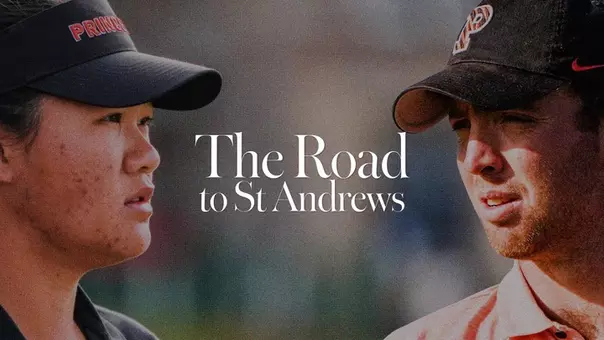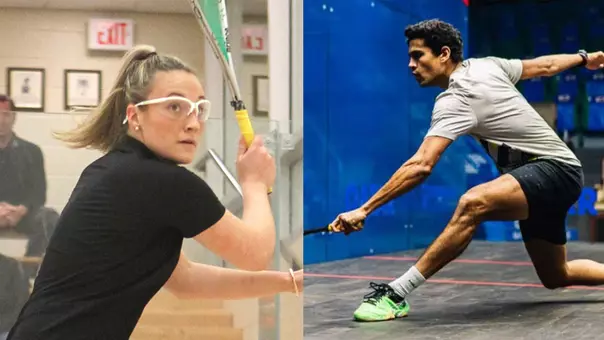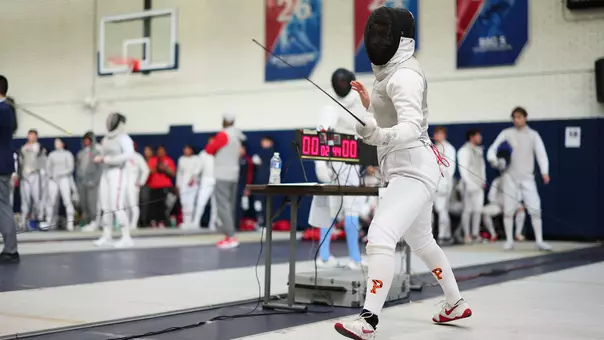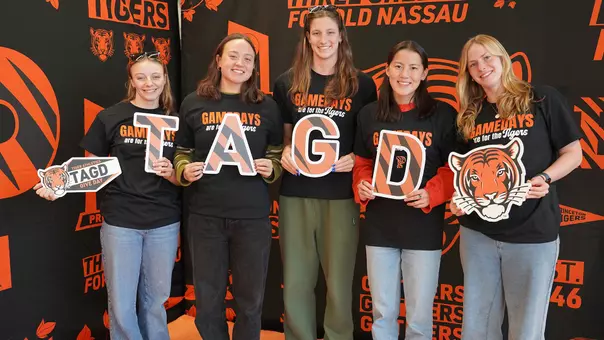Princeton University Athletics
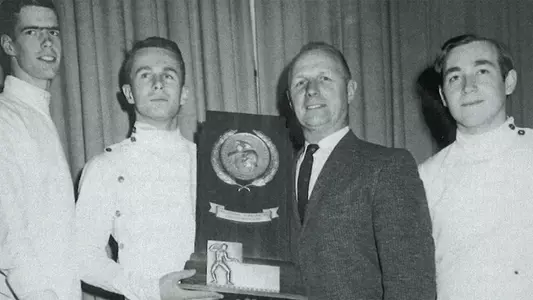
From left, Bob White, Bill Hicks, coach Stan Sieja, and John O'Sullivan.
100 Years of Princeton Fencing: The 1964 NCAA Championship
April 01, 2025 | General, Men's Fencing, Women's Fencing
We're celebrating 100 years of fencing at Princeton, and one of the great moments in program history was the 1964 NCAA team title. Nearly 50 years later, the program, with the women's program having been founded in the interim, would add the 2013 NCAA title, which ahead of the 1990 NCAA Championships became a combined title between men's and women's results.
From the book 100 Years of Princeton Fencing, written by Rob Dinerman in 2024 ahead of the fencing program's 100th anniversary, read below about the road to the 1964 NCAA title.
With the leaders of all three weapons - captain-elect Hicks (foil), his fellow second-team All-American White (epee) and Pressly (saber) - set to return in 1963-64, along with a good supporting cast for each of them, Coach Sieja felt confident about the upcoming season. The Ivy League season-opening win over Penn was noteworthy, with no fewer than seven of the 27 matches having to be decided in sudden-death dueling. In what turned out to be the key bouts of the day, sophomore Charlie Wertheimer took both of his bouts against Penn by a 5-4 margin and his fellow foilsmen Hicks and Henry "Whitey" Whiteside supplied two victories each. Conversely, in the dual meet that followed, a road loss against CCNY which was contested in front of a noisy crowd, the Beavers had seven 5-4 victories in notching their fourth straight 14-13 win over the Tigers, causing the opening sentence of the Daily Princetonian write-up to (under)state, "Princeton fencing matches against City College of New York are becoming rather frustrating." So was a late-season 14-13 loss to NYU after the Tigers had successfully triumphed over Rutgers and Ivy League rivals Cornell, Harvard and Yale.
A few days after the Harvard match, three members of the Polish Olympic team that had won a team tournament at the NYAC visited Dillon Gymnasium to participate in exhibition matches against Princeton seniors Hicks, White, O'Sullivan and Pressly. Coach Sieja was very proud of his Polish heritage and was therefore especially pleased to have fencers from that country train with his Princeton team members. Going up against some of the best fencers in the world must have been a good experience for the Tiger foursome, who along with their teammates beat Yale handily to secure a sixth consecutive Big Three crown. This victory meant that, for the second year in a row, the season-ending meet against Columbia would be for the Ivy League pennant. And for the second year in a row, the Lions fully asserted themselves, showing why they were the reigning Ivy League, Easterns and NCAA champions with a 17-10 victory that gave them the Ivy League title for the fifth consecutive year.
Perhaps still reeling from this resounding setback, the Tigers, who were expected to place in the top five in the Easterns at Annapolis, faded to seventh. Their performance was so disappointing that it left the team "defeated and demoralized," according to Daily Princetonian columnist Thomas Reid, and caused Coach Sieja to seriously consider not allowing his team to compete in the NCAA Championships, which Harvard would be hosting. He scheduled a midweek meeting with Princeton's Athletics Director Kenneth Fairman, who persuaded him to go to Cambridge after all, with the hope, as he later admitted, "that we could win third or fourth place."
Certainly neither the veteran coach nor anyone else could have foreseen what lay ahead or the incredible accomplishment that fencers Hicks (foil), White (epee) and O'Sullivan (saber) -the same trio that had finished fifth at the NCAAs one year earlier in Colorado -would achieve. Led by Hicks, who won 32 of his 33 bouts to finish first in the foil bracket and who was ably supported by White and O'Sullivan, Princeton scored a total of 81 points, two ahead of second-place NYU, to capture Princeton's first NCAA crown in any sport in the 24 years since Princeton's golf team had done so in 1940 (and the last until Princeton's men's lacrosse team emulated this feat 28 years later in 1992), as well as its first NCAA fencing team title ever. There was a 15-20 minute waiting period after the last match ended, during which the NCAA administrators totaled up all the match results. When it was finally officially announced that Princeton had won Hicks, in a combination of shock and excitement, jumped so violently into the air that both his calf muscles cramped up. His 32-victory total was the highest of any of the 105 participants representing 38 different schools, and his performance was so impressive that he received the NCAA Fencer of the Year Award at the tournament's conclusion.
Princeton's run to the championship confounded the experts. When asked to explain this outcome, Coach Sieja detailed four separate factors: his fencers' ability to duel against the many different styles they faced; the experience his threesome had gained from having all competed in the 1963 NCAA tournament; the absence of any pressure since they weren't expected to do very well in their respective weapons; and, most importantly, the team's outstanding physical condition. He had given his fencers extra work in the lead-up to the tournament -including repeated laps, running backwards around Dillon Gymnasium -to prepare them for the grueling two-day grind, and it paid tremendous dividends. "In the closing bouts Saturday night, we had the strength and stamina to be at our peak, while the boys from the other teams were wilting," he explained. Neither Hicks nor his fellow first-team All-American White had fenced prior to entering Princeton. While Hicks had played a number of the conventional sports in high school, he only started fencing because Coach Sieja spotted him in a freshman gym class and invited him to try out for the freshman team. Caprice played a role as well in Hicks's choosing fencing over hockey. Dillon Gymnasium was located right around the corner from Hicks's dorm, whereas the hockey rink was on the other end of campus. Coach Sieja had steered him into foil, which suited his attack-oriented style and whose effectiveness was enhanced by his being left-handed. Hicks had been hampered by a toe infection in his left foot during the Easterns event, but the injury fully healed prior to the NCAAs. He kept improving as the NCAA event progressed, aided as well by a previous practice session he had had with Polish fencing star Egon Francke, who would win an Olympic gold medal in the individual foil competition at the Summer Olympics in Tokyo later that year. In addition to the experience he gained from his time on the strip with such an exceptional fencer, Hicks came away from the session with some tangible rewards as well when Francke gave him a pair of shoes that were specifically designed for fencing - with soles wrapped around one side of the shoe and with gel-padded heels, a major upgrade from the Converse All-Star sneakers that Hicks had always used - and a metallic jacket wrapped much tighter to the body than Hicks had ever previously worn. This garment presented a smaller target to Hicks's opponents: indeed, during the tournament one of the opposing coaches lodged a challenge about the jacket that was resolved in Hicks's favor. There was an uplifting psychological component to wearing such fencing-specific clothing in addition to the tangible benefits they conferred.
From the book 100 Years of Princeton Fencing, written by Rob Dinerman in 2024 ahead of the fencing program's 100th anniversary, read below about the road to the 1964 NCAA title.
With the leaders of all three weapons - captain-elect Hicks (foil), his fellow second-team All-American White (epee) and Pressly (saber) - set to return in 1963-64, along with a good supporting cast for each of them, Coach Sieja felt confident about the upcoming season. The Ivy League season-opening win over Penn was noteworthy, with no fewer than seven of the 27 matches having to be decided in sudden-death dueling. In what turned out to be the key bouts of the day, sophomore Charlie Wertheimer took both of his bouts against Penn by a 5-4 margin and his fellow foilsmen Hicks and Henry "Whitey" Whiteside supplied two victories each. Conversely, in the dual meet that followed, a road loss against CCNY which was contested in front of a noisy crowd, the Beavers had seven 5-4 victories in notching their fourth straight 14-13 win over the Tigers, causing the opening sentence of the Daily Princetonian write-up to (under)state, "Princeton fencing matches against City College of New York are becoming rather frustrating." So was a late-season 14-13 loss to NYU after the Tigers had successfully triumphed over Rutgers and Ivy League rivals Cornell, Harvard and Yale.
A few days after the Harvard match, three members of the Polish Olympic team that had won a team tournament at the NYAC visited Dillon Gymnasium to participate in exhibition matches against Princeton seniors Hicks, White, O'Sullivan and Pressly. Coach Sieja was very proud of his Polish heritage and was therefore especially pleased to have fencers from that country train with his Princeton team members. Going up against some of the best fencers in the world must have been a good experience for the Tiger foursome, who along with their teammates beat Yale handily to secure a sixth consecutive Big Three crown. This victory meant that, for the second year in a row, the season-ending meet against Columbia would be for the Ivy League pennant. And for the second year in a row, the Lions fully asserted themselves, showing why they were the reigning Ivy League, Easterns and NCAA champions with a 17-10 victory that gave them the Ivy League title for the fifth consecutive year.
Perhaps still reeling from this resounding setback, the Tigers, who were expected to place in the top five in the Easterns at Annapolis, faded to seventh. Their performance was so disappointing that it left the team "defeated and demoralized," according to Daily Princetonian columnist Thomas Reid, and caused Coach Sieja to seriously consider not allowing his team to compete in the NCAA Championships, which Harvard would be hosting. He scheduled a midweek meeting with Princeton's Athletics Director Kenneth Fairman, who persuaded him to go to Cambridge after all, with the hope, as he later admitted, "that we could win third or fourth place."
Certainly neither the veteran coach nor anyone else could have foreseen what lay ahead or the incredible accomplishment that fencers Hicks (foil), White (epee) and O'Sullivan (saber) -the same trio that had finished fifth at the NCAAs one year earlier in Colorado -would achieve. Led by Hicks, who won 32 of his 33 bouts to finish first in the foil bracket and who was ably supported by White and O'Sullivan, Princeton scored a total of 81 points, two ahead of second-place NYU, to capture Princeton's first NCAA crown in any sport in the 24 years since Princeton's golf team had done so in 1940 (and the last until Princeton's men's lacrosse team emulated this feat 28 years later in 1992), as well as its first NCAA fencing team title ever. There was a 15-20 minute waiting period after the last match ended, during which the NCAA administrators totaled up all the match results. When it was finally officially announced that Princeton had won Hicks, in a combination of shock and excitement, jumped so violently into the air that both his calf muscles cramped up. His 32-victory total was the highest of any of the 105 participants representing 38 different schools, and his performance was so impressive that he received the NCAA Fencer of the Year Award at the tournament's conclusion.
Princeton's run to the championship confounded the experts. When asked to explain this outcome, Coach Sieja detailed four separate factors: his fencers' ability to duel against the many different styles they faced; the experience his threesome had gained from having all competed in the 1963 NCAA tournament; the absence of any pressure since they weren't expected to do very well in their respective weapons; and, most importantly, the team's outstanding physical condition. He had given his fencers extra work in the lead-up to the tournament -including repeated laps, running backwards around Dillon Gymnasium -to prepare them for the grueling two-day grind, and it paid tremendous dividends. "In the closing bouts Saturday night, we had the strength and stamina to be at our peak, while the boys from the other teams were wilting," he explained. Neither Hicks nor his fellow first-team All-American White had fenced prior to entering Princeton. While Hicks had played a number of the conventional sports in high school, he only started fencing because Coach Sieja spotted him in a freshman gym class and invited him to try out for the freshman team. Caprice played a role as well in Hicks's choosing fencing over hockey. Dillon Gymnasium was located right around the corner from Hicks's dorm, whereas the hockey rink was on the other end of campus. Coach Sieja had steered him into foil, which suited his attack-oriented style and whose effectiveness was enhanced by his being left-handed. Hicks had been hampered by a toe infection in his left foot during the Easterns event, but the injury fully healed prior to the NCAAs. He kept improving as the NCAA event progressed, aided as well by a previous practice session he had had with Polish fencing star Egon Francke, who would win an Olympic gold medal in the individual foil competition at the Summer Olympics in Tokyo later that year. In addition to the experience he gained from his time on the strip with such an exceptional fencer, Hicks came away from the session with some tangible rewards as well when Francke gave him a pair of shoes that were specifically designed for fencing - with soles wrapped around one side of the shoe and with gel-padded heels, a major upgrade from the Converse All-Star sneakers that Hicks had always used - and a metallic jacket wrapped much tighter to the body than Hicks had ever previously worn. This garment presented a smaller target to Hicks's opponents: indeed, during the tournament one of the opposing coaches lodged a challenge about the jacket that was resolved in Hicks's favor. There was an uplifting psychological component to wearing such fencing-specific clothing in addition to the tangible benefits they conferred.
Princeton Athletics: Ready for Gameday
Friday, December 19
Hard Cuts | Season 8 - Episode 2
Friday, December 05
Sights and Sounds: Field Hockey 2025 Ivy League Tournament Championship
Wednesday, November 12
Hard Cuts | Season 8 - Episode 1
Wednesday, November 05

